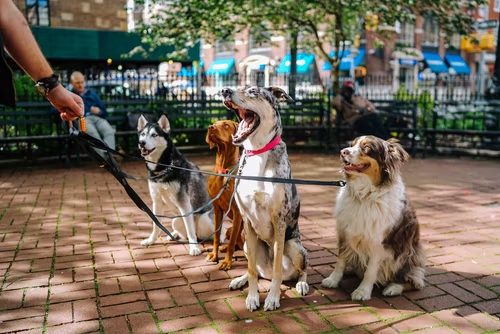9 Amazing Facts About Dogs
It's interesting to know about dogs. Their body, behavior and everything is unique. Sometimes it's difficult to differentiate fact from fiction. This article provides a list of 9 amazing facts about dogs that you should keep in your mind before adopting or buying a dog for yourself.
1. A dog’s sense of smell is 10,000 times more powerful than a human’s.
A dog's sense of smell is 10,000 times more powerful than a human's. This means that they can detect odors we can't even imagine. Dogs can smell in parts per trillion, which means that they can smell one drop of blood in an Olympic-sized swimming pool.
A dog has more than 220 million olfactory receptors in its nose, compared to about 6 million for humans. This allows them to detect things we might deem as “unnoticeable” like sweat, urine and pheromones (scent signals).
They have a much better sense of smell than humans because their noses are larger and far more sensitive than ours are. Dogs have scent glands on their paws which allow them to leave messages for other dogs when they touch something or leave their territory. These glands are also used during mating season so the male can leave his scent on the female’s hindquarters so she knows he’s interested in breeding with her (this does not mean that all dogs mark everything with their feces).
2. Dogs have a third eyelid called haw, which protects and lubricates their eyes.
The haw is a membrane that covers the eye and keeps it moist. It is transparent and looks like a tiny lid over the dog's eye. It helps to keep the eye clean by protecting it from dirt, dust and debris. The haw also protects against dryness in the air by providing moisture to the surface of the eye.
Dogs that live in areas with sandy soil often have their eyes more exposed than dogs living in other areas, so they are more prone to irritation from wind-borne particles. Moreover, dogs that spend time outdoors may also suffer from damage to their eyes due to sun exposure or excessive UV light exposure.
3. Dogs can hear four times as well as people can.
The human ear can hear frequencies between 20 and 20,000 hertz (Hz), which is around the same range as the human voice. Dogs can hear much higher frequencies, however, and have been shown to be able to detect sounds as low as 25 Hz.
Compared to humans, dogs also have a wider range of hearing. They can detect sound waves in the range of 67 to 45,000 Hz. This means that dogs can hear sounds that we cannot even perceive, such as ultrasound and infrasound.
They also have better hearing than humans in terms of frequency response (the ability to differentiate between tones). While humans can identify tones between 500 Hz and 4 kHz, dogs can hear tones up to 45 kHz!
4. When a dog dreams, he’s replaying his daily events in his mind’s eye.
Dogs have similar sleep patterns to humans. They spend about half of their time asleep and they tend to sleep in short bursts rather than long periods of uninterrupted rest.
The state of dreaming is known as rapid eye movement (REM) sleep, which means that during this stage your dog’s eyes will move rapidly back and forth under his eyelids.
During REM sleep, the brain is very active and dogs dream about things that have happened during the day or are about to happen. It’s also thought that dogs dream about what they see, smell or hear during their waking hours when they close their eyes at night time. In fact, dogs can even dream while they are awake!
So next time you catch your pup twitching in their sleep, don’t worry too much. Chances are they are just having a doggy dream!
5. Dogs do not have an appendix.
The appendix is a small pouch that is connected to the large intestine and can be found near the junction of the small and large intestines in humans. It contains lymph tissue that helps with immune function, but it has no purpose in humans.
When comparing this to dogs, we see that they do not have an appendix either. However, their bodies still need to function well despite not having a structure like an appendix to help with immune system response. This means that dogs need extra support when it comes to immunity because they don't have the same kind of built-in protection as humans do when it comes to fighting off illness and infection.
Dogs have evolved over time so that they can survive without an appendix but still maintain a healthy immune system response. This means that when your dog gets sick or injured, they're going to need more help getting better than humans do because they don't have any extra protection built into their biology like we do with our own appendixes!
6. A dog’s shoulder blades are unattached to the rest of the skeleton to allow greater flexibility for running.
A dog's shoulder blades are flexible. They can move in any direction, so the dog can turn and twist its body as it needs to. In fact, this is a big part of how dogs are able to run so quickly and for such long distances: their shoulder blades allow them to make quick turns when they're running, which helps them change direction quickly.
Dogs also have very flexible rib cages. Their lungs aren't as rigidly attached to their rib cage as ours are, so they can breathe more easily and quickly. This helps them take advantage of every breath of air they get while running!
7. They don't sweat like humans do – they only have sweat glands in their feet!
The sweat glands in dogs are primarily found in their paws. This helps them cool down when they're hot. Most dogs don't have many sweat glands, but they do have some on the pads of their feet and around their eyes.
They also don't have as much body fat as humans do, so they can't store water as easily either. If you think about it, this makes sense because they're not supposed to be running long distances like we do!
Instead of cooling themselves off by sweating like people do, dogs pant and open their mouths wide to help cool themselves off quickly. This helps them keep their body temperature down while increasing blood flow to their lungs so that they can breathe more easily.
8. Dogs can see better in dim light than humans can.
Dogs have a type of vision called “colorblindness.” They have only two types of color receptors, so they see fewer colors than humans. But dogs can see red, blue and yellow. Humans have three types of color receptors, so we can also see green and orange.
Dogs can't focus on things that are very close without moving their heads back and forth. They also don't have a fovea, which is the part of the retina where we process high-resolution images. Instead, they have a second area called the parafovea, which helps them focus on objects at different distances.
Their eyes are positioned differently than humans'. In fact, dogs' eyes are closer together than ours and rotate independently to look forward or down at an object. This makes them better hunters because they can focus on prey while keeping an eye on their owner for direction or help with catching their food!
9. A dog’s nose print is unique and can be used to identify them, just like a human's fingerprint.
Dog nose prints can be used to identify dogs, just like humans use fingerprints to identify themselves. All dogs have different nose shapes and sizes, which makes them unique like humans who also have different facial features.
Dogs can be identified using their nose prints because they have ridges on their noses that are similar to fingerprints in humans. These ridges are called papillae, which are small skin folds on the surface of the nose that help dogs smell things better. In humans, papillae are found on our fingertips and palms but not on our faces or foreheads because we don’t need them there for survival purposes like dogs do.
As you can see, the facts about dogs are plentiful and remarkable. They will amaze you and give you a greater appreciation of your favorite furry friend. You've probably learned a lot by reading this article, and we could have listed a thousand more amazing facts without even trying!
For more helpful and informative insights, visit here.





